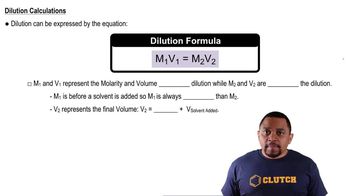Here are the essential concepts you must grasp in order to answer the question correctly.
Concentration Units
Concentration can be expressed in various units, including mass/volume percentage (m/v)%, parts per million (ppm), and molarity (M). The m/v% is calculated as the mass of solute divided by the volume of solution, multiplied by 100. PPM is a way to express very dilute concentrations, where 1 ppm equals 1 mg of solute per liter of solution. Molarity is defined as the number of moles of solute per liter of solution.
Recommended video:
Percent Concentrations Concept 1
Molar Mass Calculation
To convert between grams and moles, the molar mass of a compound is essential. For uric acid (C₅H₄N₄O₃), the molar mass is calculated by summing the atomic masses of all constituent atoms: carbon (C), hydrogen (H), nitrogen (N), and oxygen (O). This value allows for the conversion of the mass of uric acid into moles, which is necessary for calculating molarity.
Recommended video:
Dilution and Solubility
Solubility refers to the maximum amount of a solute that can dissolve in a solvent at a given temperature, expressed in g/L in this case. Understanding solubility is crucial for determining how much uric acid can be present in solution. When calculating concentrations like ppm and molarity, the solubility limits help assess whether the solution is saturated or unsaturated, influencing the calculations.
Recommended video:
 Verified step by step guidance
Verified step by step guidance


